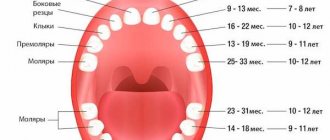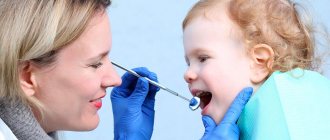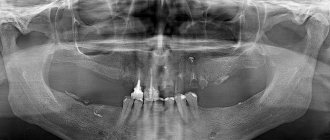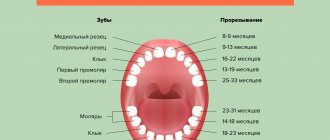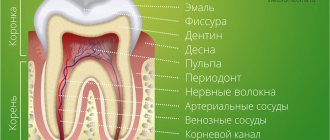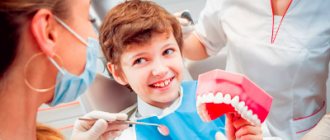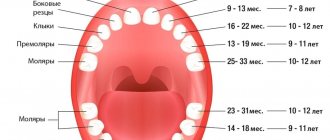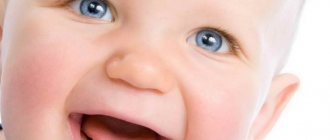Nature has provided for everything
Losing baby teeth is a natural and inevitable process that everyone goes through in childhood. Most often it begins at 5-6 years of age and passes painlessly. Sometimes the replacement of temporary teeth may begin earlier or, conversely, late. Some deviations from the usual indicators are not always considered a violation, since much depends on the health and physiological state of the child. When he begins to change his teeth, we recommend making an appointment with the dentist, as this is a very important period for the formation of your baby’s bite.
Timing for changing temporary units to permanent ones
The process of resorption of temporary roots lasts approximately 2–3 years. Its stimulation begins the moment the root comes into contact with the crown of the permanent unit. When the resorption process reaches the neck, the tooth should already begin to wobble and calmly fall out. After which permanent growth appears almost immediately in the vacant space; full growth will appear over the next 3–4 months.
The process of resorption of the milky root begins for each element of the series at a different period:
- for anterior incisors at 5 years: i.e. Their loss should occur at about 7 years of age,
- for lateral incisors at 6 years old,
- for first molars at 7 years old,
- for fangs at 8 years old,
- for second molars at 7 years of age: their roots take the longest to resolve, and fall out only by 11–14 years of age.
The process proceeds symmetrically, i.e. the roots of the same types of teeth on the upper and lower jaws, their left and right halves, resolve and fall out at approximately the same time.
What you should pay attention to
The child’s body prepares in advance for the period of teeth change. Here are the main signs of the changes taking place:
- mobility and loosening of primary teeth
- redness and swelling of the gums
- the appearance of interdental spaces due to jaw growth
- the rudiments of a permanent tooth become visible
When a baby tooth is replaced with a permanent one, the root gradually dissolves. The process is helped by a new tooth pushing out the temporary one from below.
Usually children and their parents remove the loose tooth themselves. But we recommend contacting a specialist who will provide professional assistance.
Features of changing temporary teeth to permanent ones
There are only 20 teeth in the primary dentition, although adults have from 28 to 32 (if all third molars have erupted). This significant difference is due to the structure and anatomical features of the child’s body. At a young age, the jaw is small; there is simply not enough space for so many teeth. However, as you grow older and with normal functioning of the body, the jaw grows and lengthens. This means that during the period of change in the child’s bite, not only 20 units must erupt, replacing the temporary ones, but also 8 new permanent ones, which have no milk analogues.
There are no premolars in a child's bite, so they immediately grow permanent. As the maxillofacial apparatus develops, they replace the primary molars. Total 2 pieces on the right and left on the upper and lower jaw.
In what order do teeth fall out?
The loss of baby teeth occurs in the same order in which they first erupted. First, the child loses the lower and upper incisors, then the lateral molars, and lastly the canines. The replacement of baby teeth with permanent teeth begins at the age of 5.5 years and ends at the age of 13. At the same time, instead of 20 dairy ones, 28 permanent ones grow. There is room for eight new chewing teeth due to the expansion of the jaws. By the way, wisdom teeth most often erupt in adulthood, and for some they do not grow at all.
How is the treatment carried out?
When choosing treatment tactics, the dentist takes into account:
- how old is the patient;
- how long ago the permanent unit emerged;
- how much the molar crown appeared;
- what condition is the milk unit in;
- does the child have any complaints;
- general condition of the dentition;
- the patient has a predisposition to dental anomalies.
After conducting an in-person examination, the dentist decides whether to pull out the interfering tooth or leave it and wait until its roots resolve on their own. In the first case, local anesthesia is administered and removal is carried out; in the second, the doctor tells you when the baby needs to come for a second examination. Thus, if you deal with the problem of a “shark” smile in a timely manner, it will not cause negative consequences.
What to do if a tooth does not fall out in time
According to statistics, in 20-30% of cases, children experience a “shark smile” when the permanent tooth has already erupted and is growing, but the milk tooth has not yet fallen out. Clinical studies have proven that in such a situation, parents should not hesitate to go to pediatric dentistry. The doctor will carefully examine your child's mouth and remove the temporary tooth. If you do not contact the dentist in a timely manner, double dentition can lead to improper formation of the bite, impaired diction and the functioning of the digestive system. In addition, with a “shark smile” it is difficult for a baby to bite and chew food, particles of which remain between the teeth and under the gum. As a result, inflammatory processes and caries occur. All this can be avoided by making an appointment with a specialist.
When to hesitate to see a doctor
If a “shark” problem appears and the child complains of pain, the gums are inflamed, swollen, you need to immediately get dental care. Also warning symptoms are:
- bad breath;
- bleeding of the affected gums;
- separation of pus in the area of inflammation;
- severe discomfort while chewing food.
You should not wait a day if the child has a predisposition to malocclusion, for example, if he has previously undergone treatment for malocclusion or one of the parents wore braces. In all these situations, removal should be carried out as soon as possible. This measure will be a good prevention of possible complications.
Orthodontic treatment – caring for the future
Some parents do not attach importance to the fact that the baby tooth has not yet fallen out, but the permanent one is already emerging. Or, on the contrary, the temporary one is lost early, and the tooth that replaces it does not grow. If you notice deviations, we recommend that you contact an orthodontist as soon as possible, who will provide effective treatment.
For example, with the premature loss of a baby tooth, the free space is very quickly taken up by neighboring teeth. There is not enough space for a permanent one. Therefore, it is very important when forming a temporary occlusion to fill such gaps, preventing the occurrence of an occlusion anomaly. To hold space for a permanent tooth, orthodontics uses a plate with artificial teeth. For single defects, a non-removable “ring-loop” design is most often used. The device does not cause discomfort, and the child wears it until the permanent tooth erupts.
The product manufacturing process is standard: impressions are taken, models are made, and the design is created in the laboratory within two weeks. Its fixation takes 15-20 minutes. After installing the device, you do not need to drink or eat for 2 hours. It is better to limit the consumption of “pulling” foods - toffees, chewing gum, etc.
7 questions about changing baby teeth
Parents worry when their child doesn’t have teeth for a long time, and then when they appear. They worry if there are few of them or, conversely, too many. We collected the most important questions about the timing of the replacement of milk teeth with permanent ones, as well as about possible deviations from the norm, and asked them to the winner of the competition for pediatric dentists in Russia, Yulia Selyutina.
1. What to do after a child’s baby tooth falls out - is it necessary to stop the bleeding somehow? You don't need to do anything special. After a tooth falls out, a blood clot forms in the socket within about 5 minutes. It promotes rapid wound healing. But there is no need to treat it with ointments or heat the cheek. It is also important not to rinse your mouth with anything, otherwise the clot can be accidentally removed - and then healing will take longer. By the way, it is precisely in order for this clot to form that the doctor, after removing the tooth, applies a sterile gauze swab to the wound. It must be kept in the mouth until the bleeding stops. Some children, after a tooth falls out, constantly “check” the socket with their tongue. There's nothing wrong with that. But make sure that they do not put foreign objects into their mouths. After a tooth falls out, it is better not to eat anything for an hour. You can give your child something to drink, but not anything hot. And it is advisable not to chew or bite food on the side that “lost” the tooth for a couple of days. The remaining teeth should be brushed as usual with toothpaste and a brush, morning and evening.
2. Tested remedy: a baby tooth is loose - tie a string to it and pull. Is it always good? The baby tooth begins to loosen due to the fact that its roots are dissolving. This is a natural process and in most cases the rope method can be used. Of course, provided that the child himself is not afraid to part with a tooth in this way. In addition, not all teeth are so mobile that ordinary floss can remove them. In some cases, additional effort may be required. If the baby tooth is mobile, and the child is not averse to loosening it, it does not hurt him, then he may well remove the tooth in this way. The main thing is that the child’s hands are clean during the “procedure”. If there is no result for a long time, the loose tooth has not fallen out for two weeks, it bothers the child, and he is afraid or does not want to remove it himself, then it is better to consult a doctor. The doctor can handle this one or two times. Sometimes even anesthesia is not required, or it is enough to anoint the gums with an anesthetic gel or spray with a spray.
3. Why do baby teeth not fall out on schedule? Is there something wrong with the child? The timing of the change of baby teeth indicated in various tables is arbitrary and highly averaged. Deviations in one direction or the other occur very often, and this is not a pathology or a sign of a disease. The main thing that influences the timing of the eruption and replacement of baby teeth is heredity. But no connection has yet been found between any general somatic diseases and earlier or later change of baby teeth. There is an additional research method - orthopantomogram. This is a panoramic photograph of all the teeth of both jaws at once. Having done it, you can determine the number of all the rudiments of permanent teeth, understand how the process of resorption of the roots of baby teeth is progressing, and make predictions. It is not at all necessary to conduct such a study, because it does not affect the timing of teeth change. However, an orthopantomogram can reassure parents or indicate a possible problem. For example, the absence of one or more permanent tooth buds.
4. The baby tooth has fallen out, but the permanent one is in no hurry to replace it. When is it time to worry? There are no critical deadlines. Sometimes you have to wait quite a long time for a permanent tooth to appear. For example, due to the fact that there is simply no room for it in the child’s jaw. A permanent tooth may not erupt at all if the child’s rudiment has not formed. You can take a picture of the area where the tooth is supposed to appear and find out what is causing the delay. If the tooth germ has formed and there is enough space in the jaw, be patient. Otherwise, consult an orthodontist. He will draw up a treatment plan that the child may need in the future.
5. The child lost almost all of his baby teeth in elementary school. Will his permanent ones fall out faster? Early change of teeth is quite common, it is not a pathology, not a violation of the “norm”. And it certainly doesn’t mean that permanent teeth should fall out, especially early. Unlike baby teeth, which sooner or later fall out on their own, we lose permanent teeth for some reason. For example, due to the diseases “periodontitis” or “periodontal disease”. With them, the tissue of the jaw bones dissolves and the ligamentous apparatus of the tooth is destroyed. If this happens, the teeth may become loose and even fall out. But this practically never happens in children. Even if they had “bad” baby teeth, this does not mean that there will be problems with their permanent teeth. It is important to care for them and clean them. Sometimes the use of additional means, for example, an irrigator, is simply necessary even when the teeth are still baby. Ideally, of course, your child’s oral care products should be selected by a dentist.
6. The baby tooth has not yet fallen out, it is not even loose, but the permanent one is already growing behind it. What to do? I believe that in such a situation the baby tooth should be removed by a dentist. Then ask your child to try to push the permanent tooth in the desired direction with his tongue. This is where parents' help comes in handy. Lubricate your finger with vegetable oil and perform massage movements, pushing the tooth in the desired direction. It is enough to give this mini-massage a couple of minutes a day.
7. Is it worth correcting a milk bite? Undoubtedly. Problems with bite during the period when a child has baby teeth can affect the appearance of pathologies when permanent teeth erupt. Practice shows that the sooner you start dealing with this problem, the better the results will be in the distant future. Correction or prevention of the formation of malocclusion can begin when the child turns 5-6 years old and all 20 baby teeth have erupted.
© Asya Gasimova
Doctors are our pride
We did the research and found out why they trust us. In reviews
On our website, parents note the highly qualified doctors who have knowledge of several related areas and have extensive experience
working with children
. This allows you to see the clinical picture as a whole and plan treatment correctly.
In 2021, family dentistry "DOMOSTOM" in Domodedovo entered the TOP 100 private children's dental clinics in Russia according to the rating of the expert magazine about dentistry Startsmile with the support of Kommersant Publishing House
Our clinic’s team of professionals knows how to help your child. Sign up for a consultation with us. Attentive doctors will tell you in detail about the condition of the baby’s oral cavity and answer all questions.
Guide to action for parents when changing their bite
Have you noticed that your milk units are wobbly or have already started to fall out? Explain to the child that during this period there is no need to touch the gums and loosen the teeth even more, much less disturb them with various objects, because this can lead to injury (for example, the crown and root will crumble, and fragments will remain in the gum) or the introduction of infection into the oral cavity from the outside.
Where to put baby teeth after they fall out?
The first tooth can be kept as a souvenir or given to the child to put in a box with children's valuables. If sentimentality is not accepted in your family, then the tooth can be thrown out.
In many families, the tooth is placed under the pillow to be taken away in exchange for a coin or small treat by the Tooth Fairy. This character came to us from the West. The fairy builds a castle from children's teeth in which good dreams are born.
But there is also a domestic tradition - to give a lost tooth to a mouse, which can also thank you with a gift. Previously, the tooth was thrown underground or hidden behind the stove with the words “Here, mouse, a bast tooth! Give me a bone one, mouse!” Now this story is more suitable for residents of private houses. It's up to you to decide whether it's worth chasing a mouse into an apartment on the 20th floor, even if it's a fabulous one. But you can take absolutely any magical character that your child likes and come up with a story about where and why the baby’s tooth will end up.
Interesting fact: baby teeth contain both stem and progenitor cells. Scientists believe that in the future, with the development of science and technology, baby teeth can be used for the benefit of their owners, for example, to treat serious diseases. But in order to preserve the cells in the tooth, special storage conditions are required, which, unfortunately, cannot be created at home.
Deadlines
At the age of five, teeth can become mobile. Then the process of loss and growth of new ones begins:
- six to seven years – lower and then upper central incisors;
- seven to eight years - the lateral incisors change;
- eight to ten years – first molars;
- nine to eleven years – fangs;
- eleven to thirteen are second molars.
The correct formation of the jaw depends on many factors: how the pregnancy proceeded, how long the child was breastfed, what infectious diseases were suffered, etc.
